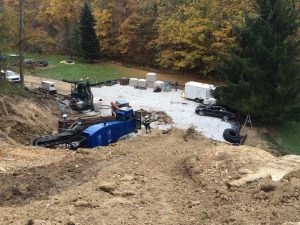When There is No Other Way
Occasionally there are HDD shots that are completed because there is simply no other way. DTD was involved in such a bore this fall, where a 12” diameter gas pipeline was being constructed across a narrow valley in Pennsylvania. The choices were:
1. Trench the pipeline through the valley,
2. Drill a 3,000’ bore beneath the valley
3. Combination of the two
While open trenching was most cost effective, geologic and topographic challenges prevented that option. The north side of the valley slope was experiencing land surface mass wasting, i.e. landslide, and the bottom of the valley had a conservation resource, a small perennial stream. Trenching and laying a pipeline through an active landslide is an inherently bad idea, and open cutting a small tributary stream creates significant ecological damage. Therefore HDD was necessary to minimize long term risk to the pipeline and ecological damage to the environment.
However, a HDD crossing of the complete valley would have required an expensive bore that also had a likelihood of inadvertent loss of drilling mud to the small surface stream. A team including the pipeline owner, engineers, the pipeline general contractor, and DTD developed the only feasible path forward. Trenching down the west side of the valley and then drilling from the bottom of the valley, under the surface stream and landslide deposit, to the top of the east side of the valley. This was not without risk, as the bore was to pass just beneath the surface stream, and over 60% of the bore length was above the drill rig, meaning this elevated section of borehole would be dry, without the support of drilling mud.

DD10 dug into the hillslope to allow space to pass under stream. Note the elevation of the hill with respect to the back of the mast.
The final challenge was that while the bore could be drilled from the bottom to the top of the valley, the product pipe to be pulled into the bore could not be assembled ahead of time due to the limited space at the top of the valley. The space available allowed only 80’ segments of pipe, and therefore required 3 hours of stop-time, for the welding, x-ray, and coating of each new section of pipe during the pullback operation.

A night time view of the 40-hour pullback viewed from the top of the bore
The 880’ bore was completed over a 30 day period, and was not without the expected challenges. The dry borehole above the rig did required the careful cleaning, and frequent swabbing with the drill tooling to maintain an open borehole. But, the highly variable geologic conditions that likely created the unstable, and landslide prone ground, also created unexpected drilling challenges. The drill tooling required to cut hard brittle rock is very different than that necessary to cut softer shales and claystones. This created the frustrating need to pull the bit from the bore and change tooling far more frequently than is ordinary in Pennsylvania drilling. And finally, the minimal space on the top of the valley meant that the pullback of the product pipe required a continuous 40 hours of operations, with many stops to weld, test, and place a corrosion resistant coating on the pipe. DTD and the pipeline construction company worked in concert to allow this difficult bore to be completed in what the only way possible.